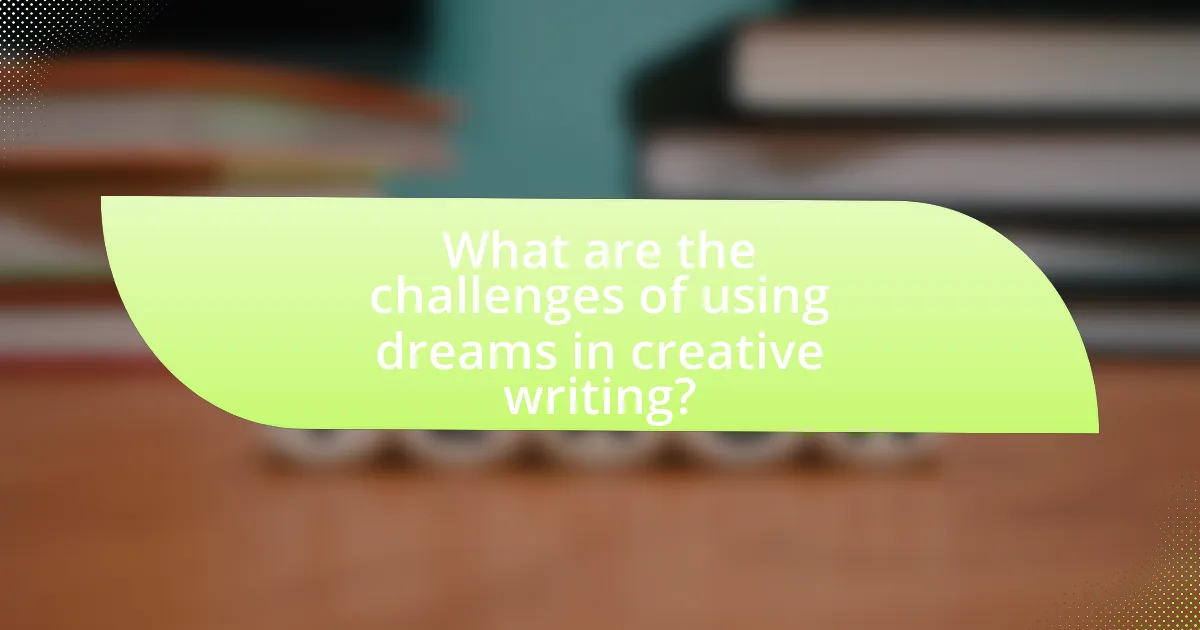The article examines the significant influence of dreams on creative writing, highlighting how dreams provide unique imagery, themes, and emotional depth that inspire writers. It discusses the psychological mechanisms behind dream-related creativity, including the brain’s activity during REM sleep and various psychological theories that support the connection between dreams and artistic expression. Key elements such as vivid imagery, emotional resonance, and narrative structure are explored, along with techniques for translating dream content into compelling narratives. Additionally, the article addresses the challenges writers face when incorporating dreams into their work and offers practical tips for enhancing creativity through dream exploration.

What is the Influence of Dreams on Creative Writing?
Dreams significantly influence creative writing by providing unique imagery, themes, and emotional depth that can inspire writers. The subconscious mind often generates surreal scenarios and vivid narratives during dreams, which can lead to innovative ideas and plot developments in writing. For instance, renowned authors like Mary Shelley and Stephen King have cited dreams as sources of inspiration for their works, demonstrating how dream content can translate into compelling storytelling. Research indicates that the brain’s activity during REM sleep fosters creativity, allowing writers to tap into their subconscious for original concepts and perspectives.
How do dreams inspire creative writing?
Dreams inspire creative writing by providing unique and vivid imagery, unconventional narratives, and emotional depth that can enhance storytelling. The subconscious mind generates scenarios and characters during dreams that often defy logical constraints, allowing writers to explore innovative ideas and themes. For instance, renowned author Stephen King has cited dreams as a source of inspiration for his novels, illustrating how dream content can translate into compelling narratives. Additionally, research published in the journal “Consciousness and Cognition” indicates that dreams can stimulate creativity by fostering divergent thinking, which is essential for generating original ideas. This connection between dreams and creativity underscores their significant role in the writing process.
What elements of dreams are most impactful for writers?
The most impactful elements of dreams for writers include vivid imagery, emotional resonance, and narrative structure. Vivid imagery in dreams often provides striking visual details that can inspire descriptive language and settings in writing. Emotional resonance captures the intense feelings experienced during dreams, which can enhance character development and thematic depth. Narrative structure, often nonlinear and surreal in dreams, can encourage writers to experiment with unconventional storytelling techniques. Research by Deirdre Barrett in “The Committee of Sleep” highlights how dreams can serve as a source of creative problem-solving and inspiration, demonstrating their significant influence on the writing process.
How can writers translate dream imagery into narrative?
Writers can translate dream imagery into narrative by employing vivid descriptions and symbolic interpretations that capture the essence of the dream experience. This involves detailing sensory elements, such as colors, sounds, and emotions, to create an immersive atmosphere that reflects the dream’s surreal quality. For instance, a dream featuring a flying scene can be depicted through dynamic language that conveys freedom and exhilaration, while also exploring the underlying emotions associated with flight, such as escape or fear.
Additionally, writers can utilize dream logic, which often defies conventional narrative structures, to enhance the narrative’s fluidity and unpredictability. This approach allows for a more authentic representation of the dream state, where transitions between scenes may be abrupt or illogical, mirroring the way dreams unfold. By integrating these techniques, writers can effectively convey the complexity and richness of dream imagery, making it resonate with readers on a deeper level.
Why are dreams considered a source of creativity?
Dreams are considered a source of creativity because they often present unique and unconventional ideas that are not constrained by the logical limitations of waking thought. During REM sleep, the brain engages in a process of associative thinking, allowing for the combination of disparate concepts, which can lead to innovative solutions and artistic inspiration. Research by neuroscientist Mark Solms indicates that dreams facilitate problem-solving by integrating emotional experiences with cognitive processes, thus enhancing creative thinking. This ability to merge unrelated thoughts and emotions is why many artists and writers, including Salvador Dalí and Mary Shelley, have credited their dreams as pivotal in their creative works.
What psychological theories support the connection between dreams and creativity?
Psychological theories that support the connection between dreams and creativity include the Activation-Synthesis Theory and the Continuity Hypothesis. The Activation-Synthesis Theory, proposed by Hobson and McCarley in 1977, suggests that dreams result from the brain’s attempt to make sense of random neural activity during sleep, which can lead to novel associations and creative insights. The Continuity Hypothesis, articulated by Calvin Hall, posits that dreams reflect waking life experiences and thoughts, allowing for the exploration of ideas and emotions in a creative context. Research indicates that individuals who engage with their dreams often report enhanced creative problem-solving abilities, supporting the notion that dreams can serve as a fertile ground for creative inspiration.
How do cultural perceptions of dreams influence creative expression?
Cultural perceptions of dreams significantly influence creative expression by shaping the themes, symbols, and narratives that artists and writers incorporate into their work. For instance, in many Indigenous cultures, dreams are viewed as a vital source of guidance and inspiration, leading to the incorporation of dream imagery and spiritual symbolism in storytelling and visual arts. In contrast, Western cultures often interpret dreams through a psychological lens, as seen in the works of Sigmund Freud and Carl Jung, which encourages exploration of the subconscious in literature and art. This divergence in understanding dreams results in varied creative outputs; for example, the surrealist movement in Europe drew heavily on dream symbolism to challenge reality, while Native American storytelling often integrates dreams as a means of connecting with ancestral wisdom. Thus, cultural perceptions of dreams not only inform the content of creative works but also influence the methods and styles employed by artists and writers across different societies.

How do writers utilize dreams in their creative process?
Writers utilize dreams as a source of inspiration and creativity in their writing process. Dreams often present unique narratives, vivid imagery, and emotional experiences that can be transformed into compelling stories or characters. For instance, renowned author Stephen King has acknowledged that many of his plots are inspired by dreams, illustrating how subconscious thoughts can lead to innovative ideas. Additionally, research by psychologist Carl Jung emphasized that dreams can reveal hidden aspects of the psyche, providing writers with deeper insights into character development and thematic exploration. This connection between dreams and creativity highlights their significance in the artistic process.
What techniques do writers use to capture dream content?
Writers use techniques such as free writing, vivid imagery, and stream of consciousness to capture dream content. Free writing allows authors to transcribe thoughts and feelings immediately upon waking, preserving the raw essence of dreams. Vivid imagery helps convey the surreal and often illogical nature of dreams, making them relatable and engaging for readers. Stream of consciousness mimics the fluid and fragmented thought patterns experienced in dreams, allowing writers to reflect the disjointed narrative style typical of dream sequences. These techniques are effective in translating the ephemeral nature of dreams into structured narratives, enhancing the creative writing process.
How can journaling dreams enhance a writer’s creativity?
Journaling dreams can enhance a writer’s creativity by providing a rich source of inspiration and unique narrative ideas. Dreams often contain surreal imagery, unexpected plot twists, and emotional depth that can stimulate a writer’s imagination. Research indicates that engaging with dream content can lead to increased problem-solving abilities and creative thinking, as demonstrated in a study by Deirdre Barrett published in “The Journal of Creative Behavior,” which found that individuals who recorded their dreams reported higher levels of creativity in their work. By reflecting on and interpreting their dreams, writers can unlock new perspectives and themes, ultimately enriching their storytelling.
What role does dream interpretation play in writing?
Dream interpretation plays a significant role in writing by providing insights into the subconscious mind, which can inspire creativity and narrative development. Writers often utilize dreams as a source of symbolism and themes, allowing them to explore complex emotions and ideas that may not be easily accessible in waking life. For instance, renowned authors like Franz Kafka and Stephen King have drawn upon their dreams to create compelling narratives, demonstrating how dream content can serve as a catalyst for storytelling. This connection between dreams and writing is supported by psychological theories, such as those proposed by Sigmund Freud, who emphasized the importance of dreams in revealing hidden desires and conflicts, thus enriching the writer’s creative process.
How can dreams shape character development in writing?
Dreams can significantly shape character development in writing by providing insights into a character’s subconscious desires, fears, and motivations. Through dreams, writers can explore complex emotional landscapes, revealing hidden aspects of a character’s personality that may not surface in their waking life. For example, a character’s recurring nightmare about failure can illustrate their deep-seated insecurities, influencing their actions and decisions throughout the narrative. This technique is supported by psychological theories, such as those proposed by Sigmund Freud, who emphasized the importance of dreams in understanding human behavior and personality. By integrating dreams into character arcs, writers can create more nuanced and relatable characters, enhancing the overall depth of the story.
What types of characters can be inspired by dreams?
Characters inspired by dreams can include surreal figures, archetypal personas, and emotionally charged representations. Surreal figures often embody the bizarre and illogical aspects of dreams, such as talking animals or fantastical creatures, reflecting the dreamer’s subconscious thoughts. Archetypal personas, like the hero or the mentor, can emerge from universal themes present in dreams, drawing on collective human experiences. Additionally, emotionally charged representations may depict the dreamer’s fears, desires, or unresolved conflicts, allowing for deep character exploration. This connection between dreams and character creation is supported by psychological theories, such as Carl Jung’s concept of the collective unconscious, which suggests that dreams tap into shared human symbols and themes.
How do dream scenarios influence character motivations?
Dream scenarios significantly influence character motivations by providing insights into their subconscious desires and fears. These scenarios often reveal hidden aspects of a character’s psyche, driving their actions and decisions in the narrative. For instance, a character experiencing a dream of failure may become more determined to succeed in their waking life, reflecting a motivation rooted in overcoming internal conflict. Research by Freud in “The Interpretation of Dreams” emphasizes that dreams serve as a window into the unconscious, suggesting that characters shaped by dream experiences can exhibit more complex and relatable motivations. This connection between dreams and character motivations enhances narrative depth and emotional resonance in creative writing.

What are the challenges of using dreams in creative writing?
Using dreams in creative writing presents challenges such as the difficulty of translating abstract dream imagery into coherent narrative and the potential for disjointed storytelling. Dreams often lack a clear structure, making it hard for writers to create a logical flow that resonates with readers. Additionally, the subjective nature of dreams can lead to misinterpretation, as what is meaningful to one writer may not be relatable to an audience. Research indicates that while dreams can inspire creativity, their surreal qualities can complicate the writing process, requiring writers to find a balance between dreamlike elements and narrative clarity.
What common pitfalls do writers face when incorporating dreams?
Writers commonly face pitfalls such as lack of clarity, overuse of symbolism, and disconnection from the narrative when incorporating dreams. Lack of clarity occurs when dreams are presented in a way that confuses readers rather than enhancing the story, making it difficult for them to understand the intended message. Overuse of symbolism can lead to dreams feeling forced or overly complex, detracting from the overall narrative rather than enriching it. Additionally, disconnection from the narrative happens when dreams do not align with the characters’ arcs or the plot, resulting in a jarring experience for the reader. These pitfalls can undermine the effectiveness of dreams as a creative tool in writing.
How can writers avoid clichés when writing about dreams?
Writers can avoid clichés when writing about dreams by focusing on unique, personal experiences and employing vivid, specific imagery. By drawing from their own dream experiences or those of others, writers can create original narratives that reflect individual emotions and thoughts, steering clear of overused phrases and tropes. Research indicates that personal storytelling enhances authenticity and engagement, making the writing more relatable and impactful. For instance, a study published in the Journal of Creative Writing Studies highlights that personal anecdotes in creative writing foster deeper connections with readers, thereby reducing reliance on clichés.
What strategies can help maintain coherence in dream-inspired narratives?
To maintain coherence in dream-inspired narratives, writers should employ strategies such as establishing a clear thematic framework, utilizing consistent character development, and integrating logical transitions between scenes. A thematic framework provides a guiding principle that aligns the narrative elements, ensuring that even surreal aspects relate back to the central theme. Consistent character development allows readers to follow character arcs despite the dreamlike quality, making the narrative more relatable. Logical transitions help bridge disparate scenes, creating a sense of continuity that enhances reader engagement. These strategies are supported by narrative theory, which emphasizes the importance of structure and coherence in storytelling, as outlined in works like “The Narrative Paradigm” by Walter Fisher.
How can writers effectively blend dreams with reality in their stories?
Writers can effectively blend dreams with reality in their stories by using vivid imagery and symbolic elements that reflect the emotional truths of both realms. This technique allows the dream sequences to resonate with the reader while maintaining a connection to the real-world context of the narrative. For example, incorporating dream-like descriptions of settings or characters can evoke a surreal atmosphere that mirrors the protagonist’s inner conflicts or desires, thereby enhancing the story’s emotional depth. Additionally, authors like Haruki Murakami often intertwine dream sequences with realistic events, creating a seamless transition that invites readers to explore the subconscious motivations of characters. This method not only enriches the narrative but also engages readers on a psychological level, making the blending of dreams and reality a powerful storytelling tool.
What narrative techniques facilitate the integration of dreams and real-life events?
Narrative techniques that facilitate the integration of dreams and real-life events include stream of consciousness, nonlinear storytelling, and symbolism. Stream of consciousness allows authors to present characters’ thoughts and dreams in a fluid manner, blurring the lines between reality and imagination. Nonlinear storytelling disrupts chronological order, enabling the juxtaposition of dream sequences with real-life events, which can create a more immersive experience. Symbolism serves as a bridge between dreams and reality, where objects or themes in dreams can represent deeper truths or emotions in the characters’ waking lives. These techniques are evident in works like Virginia Woolf’s “To the Lighthouse,” where the fluidity of thought and time enhances the connection between dreams and reality.
How can contrasting dream sequences with reality enhance storytelling?
Contrasting dream sequences with reality enhances storytelling by creating a dynamic interplay that deepens character development and thematic exploration. This technique allows writers to illustrate the characters’ inner conflicts, desires, and fears, often revealing truths that are obscured in waking life. For instance, in literature, works like “Alice’s Adventures in Wonderland” by Lewis Carroll utilize dream sequences to explore themes of identity and perception, showcasing how the surreal can reflect the complexities of reality. By juxtaposing the illogical nature of dreams with the structured world, authors can evoke emotional responses and provoke thought, ultimately enriching the narrative experience.
What practical tips can enhance the use of dreams in creative writing?
To enhance the use of dreams in creative writing, writers should maintain a dream journal to capture vivid details immediately upon waking. This practice allows for the preservation of unique imagery and emotions that can inspire narrative elements. Additionally, writers can explore dream symbolism by researching common interpretations, which can deepen the thematic layers of their work. Engaging in free writing based on dream content can also stimulate creativity, as it encourages the flow of ideas without self-censorship. Furthermore, incorporating dream sequences into stories can create surreal experiences that challenge readers’ perceptions, as seen in works by authors like Franz Kafka and Haruki Murakami, who effectively utilize dreams to blur the lines between reality and imagination.
How can writers develop a habit of dream recall for inspiration?
Writers can develop a habit of dream recall for inspiration by maintaining a dream journal and practicing mindfulness techniques. Keeping a journal next to the bed allows writers to immediately record dreams upon waking, which enhances memory retention. Research indicates that writing down dreams shortly after waking can significantly improve recall, as the brain is most receptive to these memories during this time. Additionally, mindfulness practices, such as meditation, can increase awareness of dreams and improve overall recall ability. Studies show that individuals who engage in mindfulness are better at remembering their dreams, which can provide rich material for creative writing.
What exercises can help writers explore dream themes in their work?
Writers can explore dream themes in their work through exercises such as dream journaling, guided imagery, and free association writing. Dream journaling involves recording dreams immediately upon waking, which helps capture vivid details and emotions that can inspire narrative elements. Guided imagery exercises prompt writers to visualize dream scenarios and then describe them in detail, fostering creativity and thematic exploration. Free association writing encourages writers to write continuously for a set period about any thoughts or images that arise from their dreams, allowing subconscious connections to surface. These methods are effective because they engage the writer’s imagination and tap into the rich symbolism often found in dreams, enhancing their creative output.
